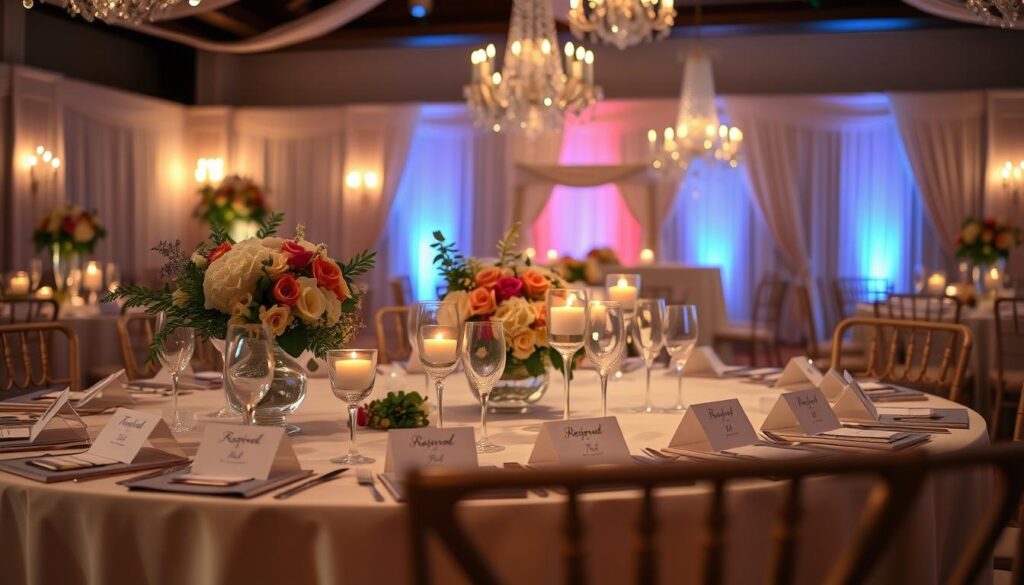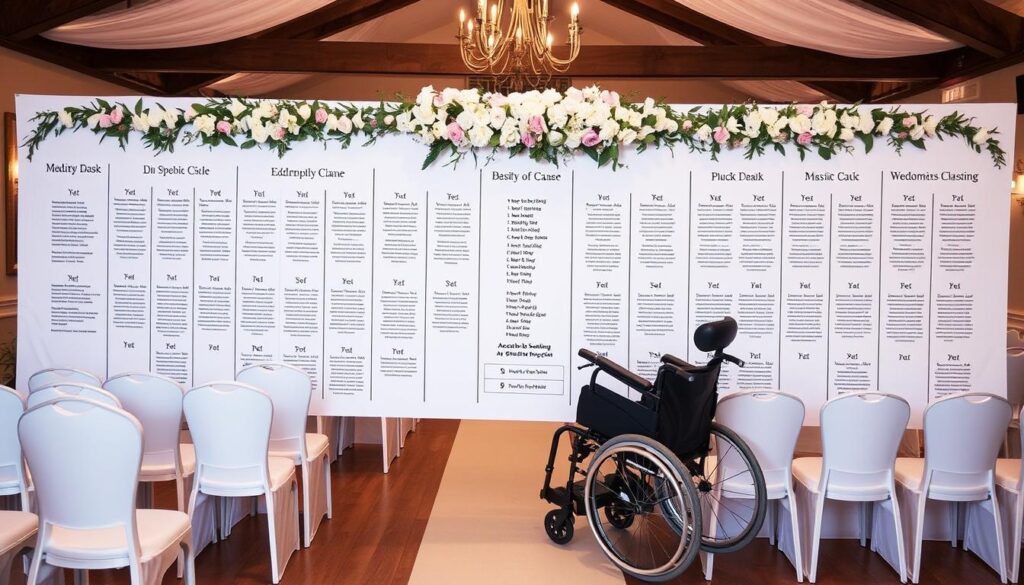As you embark on the exciting journey of planning your dream wedding, one crucial element often overlooked is the seating chart. However, a thoughtfully crafted seating arrangement can make all the difference in ensuring your guests feel comfortable, connected, and truly welcomed on your special day.
In this comprehensive article, we’ll delve into the art of creating a seating chart that not only optimizes the flow and functionality of your wedding reception but also enhances the overall guest experience. From understanding the fundamentals of seating arrangements to navigating family dynamics and cultural considerations, we’ll equip you with the knowledge and strategies to transform your wedding into a seamless, memorable celebration.
Whether you’re planning an intimate gathering or a grand affair, the seating chart is the backbone of your wedding reception. By mastering the art of strategic seating, you’ll have the power to create an environment where your guests feel valued, connected, and truly immersed in the joyous occasion.
Understanding the Basics of Wedding Seating Arrangements
When it comes to planning a wedding, one of the crucial elements to consider is the seating arrangement. The layout and organization of your event space can significantly impact the overall guest experience. Whether you opt for round tables, long tables, or a mix-and-match approach, understanding the fundamentals of wedding seating arrangements is essential for creating a cohesive and welcoming atmosphere.
One key factor to consider is the size of your tables and the number of guests per table. Striking the right balance between intimate, cozy seating and ample space for mingling is crucial. Event Space Planning can help you determine the optimal table sizes and guest capacity to ensure a comfortable and inviting setting for your wedding reception.
In addition to the physical layout of the tables, the flow of the reception space is also crucial. Reserved Seating Arrangements can help you create a seamless experience, guiding your guests to their designated seats and facilitating smooth transitions throughout the event. By carefully considering the overall spatial dynamics, you can enhance the guest experience and ensure that your wedding reception runs smoothly.
Ultimately, understanding the basics of wedding seating arrangements is a vital component of creating a memorable and enjoyable celebration for both you and your guests. By striking the right balance between aesthetics, functionality, and guest comfort, you can set the stage for a truly unforgettable wedding day.
Creating a Stress-Free Wedding Reception Layout
Crafting a seamless Audience Flow Management and effective Crowd Control Techniques is crucial for ensuring a stress-free wedding reception. By strategically positioning key elements, you can minimize congestion and create a harmonious guest experience.
Start by carefully placing the dance floor, ensuring it’s situated in a central location that encourages guests to gather and celebrate. Surrounding the dance floor with the bar and buffet stations can help direct the flow of traffic, guiding guests to refresh themselves before hitting the dance floor.
Moreover, establishing clear pathways for guest movement and service staff navigation is essential. Designate specific entry and exit points, and use visual cues, such as signage or floor decals, to guide guests through the reception area. This not only enhances the overall flow but also allows catering and service staff to efficiently tend to their duties without disrupting the festivities.
By thoughtfully designing the wedding reception layout, you can create an environment that celebrates the union of the couple while ensuring a stress-free and enjoyable experience for all in attendance.
Seating Chart Strategies That Enhance Guest Experience
Designing a seating chart for your wedding can be a strategic endeavor, with the potential to enhance the overall guest experience. One effective technique is to mix guests from different social circles, encouraging them to mingle and forge new connections. By seating individuals with common interests or hobbies together, you can foster meaningful conversations and a lively atmosphere.
Another impactful strategy is to create conversation starter elements at each table, such as thought-provoking questions or interactive activities. These elements can break the ice and facilitate engaging discussions, ensuring that your guests feel comfortable and entertained throughout the event. Remember, a well-planned seating chart can contribute to a memorable and enjoyable celebration for all attendees.
Moreover, strategic seating can also play a role in optimizing General Admission Configurations and Ticket Sales Maximization for your wedding. By carefully arranging the seating layout, you can create a seamless flow of movement and minimize bottlenecks, ensuring a smooth and efficient guest experience. This attention to detail can translate into higher satisfaction levels and increased Ticket Sales Maximization for your special day.
Ultimately, the seating chart is a critical component in shaping the overall atmosphere and guest experience at your wedding. By employing thoughtful strategies, you can foster an environment that encourages mingling, conversation, and a sense of community among your loved ones, creating a truly memorable celebration.
Navigating Family Dynamics in Wedding Seating
Crafting a seating chart for your wedding can be a delicate dance, especially when navigating the complex dynamics of family relationships. Whether you’re dealing with divorced parents, blended families, or potential conflicts between relatives, the Reserved Seating Arrangements and Seating Chart Strategies you employ can make all the difference in creating a harmonious and inclusive experience for your guests.
One key approach is to prioritize open communication with all involved parties. Take the time to understand their concerns and preferences, and work together to find a solution that respects everyone’s needs. This may involve strategically placing guests to minimize tensions or creating separate tables for different family groups.

Additionally, consider incorporating thoughtful gestures, such as reserved seating for elders or special signage to guide guests to their designated spots. These small touches can go a long way in making your loved ones feel valued and ensuring a positive event for all.
By taking a proactive and empathetic approach to your wedding seating, you can navigate the complex web of family dynamics and create an atmosphere of joy and celebration. With careful planning and open communication, your Seating Chart Strategies can become a powerful tool for bringing people together on your special day.
Digital Tools and Software for Wedding Seating Planning
In the ever-evolving world of wedding planning, innovative digital tools and software have revolutionized the way couples approach seating arrangements. From intuitive event space planning platforms to sophisticated venue layout optimization software, these cutting-edge solutions are transforming the way couples create seamless and personalized seating charts for their special day.
One of the standout features of these digital tools is their ability to simplify the often-daunting task of managing guest seating. Wedding planning apps, for instance, offer user-friendly interfaces that allow couples to easily input guest information, arrange tables, and visualize the event space layout. These interactive platforms often include drag-and-drop functionality, enabling couples to effortlessly rearrange seating based on guest preferences or last-minute changes.
Specialized seating chart software, on the other hand, takes the planning process to the next level. These sophisticated programs offer advanced features like automated table assignments, real-time guest RSVP tracking, and even the ability to generate printable seating charts and place cards. By leveraging these digital tools, couples can ensure their event space is optimized for a seamless and enjoyable guest experience.
Whether couples prefer the user-friendly approach of wedding planning apps or the comprehensive features of seating chart software, these digital solutions have become invaluable resources in the world of event space planning and venue layout optimization. With their ability to streamline the seating arrangement process, couples can focus on the other exciting aspects of their wedding day, confident that their guests will be seated in comfort and style.
Accommodating Special Needs and Accessibility Requirements
When crafting your wedding seating chart, it’s crucial to consider Accessibility Considerations and ensure that all your guests feel comfortable and included. This means carefully addressing the needs of attendees with mobility issues, hearing or visual impairments, and dietary restrictions.
For guests with physical disabilities, strategic seating placement near entrances, elevators, and accessible restrooms can make a significant difference. Providing ample space around tables and ensuring clear pathways for wheelchair users is essential. Additionally, coordinating with your venue to confirm compliance with Fire Safety Compliance regulations is a must.

Attendees with hearing or visual impairments may require specialized accommodations, such as reserved seating near the stage or interpreters. Offering large-print or Braille versions of your seating chart can also help these guests navigate the reception with ease.
When it comes to dietary needs, be proactive in gathering information from your guests and working closely with your caterer. Designating tables or sections for guests with specific dietary restrictions can ensure they are well-catered for and feel included in the celebration.
By thoughtfully incorporating these Accessibility Considerations into your seating chart, you can create a welcoming and inclusive environment for all your guests, allowing them to fully enjoy your special day.
Cultural Considerations in Wedding Seating Arrangements
When it comes to wedding seating arrangements, cultural traditions play a significant role in shaping the layout and dynamics of the event. Reserved Seating Arrangements and Seating Chart Strategies can be greatly influenced by the customs and beliefs of the couple and their families. Understanding these cultural nuances is crucial in creating an inclusive and harmonious environment for all guests.
In some cultures, the bride’s and groom’s families are seated separately, with the bride’s family on one side and the groom’s on the other. This practice ensures that the families can easily interact and celebrate the union. In other traditions, the seating may be organized by gender, with men and women seated in distinct sections. Incorporating these cultural elements can add a unique touch to the wedding and honor the couple’s heritage.
Navigating the balance between cultural expectations and modern Seating Chart Strategies can be a delicate process. Wedding planners and couples must work closely to find ways to respect cultural traditions while also creating a comfortable and inclusive environment for all guests. This may involve designating specific areas for cultural practices, such as a separate table for elders or a designated space for traditional dances.
By embracing cultural considerations in wedding seating arrangements, couples can create a celebration that truly reflects their unique backgrounds and brings together their families and communities in a harmonious and meaningful way. A well-planned Reserved Seating Arrangements and Seating Chart Strategies can help make all guests feel welcomed and valued, ensuring a memorable and joyful wedding experience.
Maximizing Your Venue Space for Optimal Flow
As you finalize the seating arrangements for your wedding reception, it’s crucial to consider how to best utilize the available venue space. By strategically organizing the layout, you can create a seamless flow that enhances the guest experience. Venue Layout Optimization and Audience Flow Management are key factors to keep in mind.
Start by evaluating the unique characteristics of your venue, whether it’s an intimate indoor setting or a spacious outdoor space. Identify potential focal points, such as the dance floor or the head table, and organize the seating around these areas to encourage interaction and engagement. Carefully consider the placement of tables, ensuring there is ample room for guests to move freely without feeling cramped or crowded.
Effective Venue Layout Optimization also involves maximizing seating capacity without compromising comfort. By arranging tables in a strategic manner, you can accommodate more guests while still providing them with a comfortable and enjoyable experience. Experiment with different table shapes and sizes, and explore creative seating arrangements that optimize the available space.




